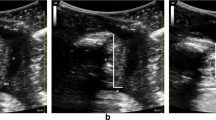Abstract
The aim of this study was to examine the reproducibility of ultrasound (US) findings relating to pelvic floor muscle in women with urinary incontinence (UI). Eighteen women with UI were examined twice by the same examiners over an interval of 1 month. The US findings comprised of (1) distance between bladder neck and symphysis pubis (BN/SP) at rest, during contraction, and while performing the Valsalva maneuver and (2) distance between anorectal angle and symphysis pubis (AR-SP) during the same conditions. Statistical analysis included test–retest correlations (ICC3,K), and the assessment of measurement error and smallest real difference (SRD) for change. BN-SP and AR-SP exhibited high ICCs. The lowest SRD values related to the AR-SP variables (10–19%). US-based measures of the bladder neck and the anorectal angle, distance, and displacement seem to offer reasonable clinical reproducibility.


Similar content being viewed by others
References
Sapsford R (2001) The pelvic floor—a clinical model for functional rehabilitation. Physiotherapy 87:620–630
DeLancey JOL, Morgan DM, Fenner DE, Kearney R, Guire K, Miller JM, Hussain H, Umek W, Hsu Y, Ashton-Miller JA (2007) Comparison of levator ani muscle defects and function in women with and without pelvic organ prolapse. Obstet Gynecol 109:295–302
Bo K (2005) Evaluation of female pelvic floor function and strength. Phys Ther 85:269–282
Messelink B, Benson T, Berghmans B, Bo K, Corcos J, Fowler C, Laycock J, Huat CLM, Van Lunsen R, Guus LN, Pemberton J, Wang A, Watier A, Van Kerrebroeck P (2005) Standardization of terminology of pelvic floor muscle function and dysfunction: report from the pelvic floor clinical assessment group of the International Continence Society. Neurourol Urodyn 24:374–380
Bo K, Borg FH (2001) Vaginal palpation of pelvic floor muscle strength: inter-test reproducibility comparison between palpation and vaginal squeeze pressure. Acta Obstet Gynecol Scand 80:883–887
Peschers UM, Gingelmaier K, Jundt B, Dimpfl LT (2001) Evaluation of pelvic floor muscle strength using four different techniques. Int Urogynecol J 12:27–30
Tunn R, Schaer G, Peschers U, Bader W, Gauruder A, Hanzal E, Koelbl H, Koelle D, Perucchini D, Petri E, Riss P, Schuessler B, Viereck V (2005) Updated recommendations on ultrasonography in urogynecology. Int Urogynecol J 16(3):236–241
Beer-Gabel M, Teshler M, Barzilai N, Lurie Y, Malnick S, Bass D, Zbar A (2002) Dynamic transperineal ultrasound in the diagnosis of pelvic floor disorders: pilot study. Dis Colon Rectum 45(2):239–245
Dietz HP, Wilson PD, Clark B (2001) The use of perineal ultrasound to quantify levator activity and teach pelvic floor muscle exercises. Int Urogynecol J 12:166–169
Dietz HP, Jarvis SK, Vancaillie TG (2002) The assessments of levator muscle strength: a validation of 3 ultrasound techniques. Int Urogynecol J 13:156–159
Tunn R, Petri E (2003) Introital and transvaginal ultrasound as the main tool in the assessment of urogenital and pelvic floor dysfunction: an imaging panel and practical approach. Ultrasound Obstet Gynecol 22(2):205–213
Dietz HP (2004) Ultrasound imaging of the pelvic floor. Part І: two-dimensional aspects. Ultrasound Obstet Gynecol. 23:80–92
Thompson JA, O, Sullivan PB, Briffa NK, Neumann P (2006) Assessment of voluntary pelvic floor muscle contraction in continent and incontinent women using transperineal ultrasound, manual muscle testing and vaginal squeeze pressure measurements. Int Urogynecol J 17(6):624–630 doi:10.1007/s00192-006-0081-2
Beco J, Leonard D, Lambotte R (1994) Study of the artifacts induced by linear array transvaginal ultrasound scanning in urodynamics. World J Urol 12(6):329–332
Dietz HP, Lanzarone V (2005) Levator trauma after vaginal delivery. Obstet Gynecol 106:707–712
Dietz HP (2006) Quantification of major morphological abnormalities of the levator ani. Ultrasound Obstet Gynecol 29:329–334
Abrams P, Cardozo L, Fall M, Griffiths D, Rosier P, Kerrebroeck UUP, Victoer A, Wein A (2002) The standardization of terminology of lower urinary tract function: report from the standardization sub-committee of the ICS. Am J Obstet Gynecol 187:116–126
Flansbjer UB, Holmbäck AM, Downham D, Lexell J (2005) What change in isokinetic knee muscle strength can be detected in men and women with hemiparesis after stroke? Clin Rehabil 19(5):514–522
Rothestein JM, Campbell JL, Echternach JL, Jette AM, Knecht HG, Rose SJ (1991) Standards for test and measurements in physical therapy practice. Phys Ther 71:589–622
Dietz H, Shek K, Clarke B (2005) Biometry of the pubovisceral muscle and levator hiatus by three-dimensional pelvic floor ultrasound. Ultrasound Obstet Gynecol 25:580–585
De Leon J, Steensma AB, Shek C, Dietz HP (2007) Ballooning: how to define abnormal distensibility of the levator hiatus. Ultrasound Obstet Gynecol 30(4):447
Dietz HP (2004) Levator function before and after childbirth. Aust N Z J Obstet Gynecol 44:19–23
Pregazzi R, Sartore A, Bortoli P, Grimaldi E, Troiano L, Guaschino S (2002) Perineal ultrasound evaluation of urethral angle and bladder neck mobility in women with stress urinary incontinence. BJOG 109:821–827
Masata J, Svabic K, Martan A, Drahoradova P, Pvlikova M (2005) What ultrasound parameter is optimal in the examination of position and mobility of urethrovesical junction? Ceska Gynekol 70(4):280–285
Conflicts of interest
None.
Author information
Authors and Affiliations
Corresponding author
Rights and permissions
About this article
Cite this article
Gottlieb, D., Dvir, Z., Golomb, J. et al. Reproducibility of ultrasonic measurements of pelvic floor structures in women suffering from urinary incontinence. Int Urogynecol J 20, 309–312 (2009). https://doi.org/10.1007/s00192-008-0771-z
Received:
Accepted:
Published:
Issue Date:
DOI: https://doi.org/10.1007/s00192-008-0771-z




